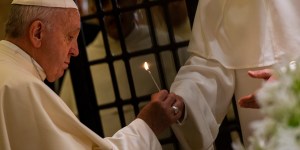Lenten Campaign 2025
This content is free of charge, as are all our articles.
Support us with a donation that is tax-deductible and enable us to continue to reach millions of readers.
Praying without letting your mind wander is always difficult — especially when a prayer’s words come automatically, as they do with the Lord’s Prayer.
Fulton Sheen used to illustrate the point by telling the story of St. Bernard of Clairvaux’s encounter with a farmer who claimed he wasn’t distracted in prayer. “I’ll give you my mule if you can say a single Our Father without distraction,” said the saint.
The farmer agreed, then recited the prayer. When he got to “Give us this day our daily, bread,” the farmer added, “Can you please throw in the bridle and saddle as well?”
Three images can help you focus on the Our Father. They are in front of many of us at Mass.
The first way is to focus on the crucifix.
Our Father who art in heaven, hallowed be thy name.
As Jesus approached the crucifixion, he prayed, “Father, glorify thy name.” Then a voice came from heaven, “I have glorified it, and I will glorify it again.” The crucifixion is Jesus’ “hallowed be thy name” to the Father.
Thy kingdom come.
Jesus is crowned with thorns beneath a sign that says “The king of the Jews.” The cross is the only way the true kingdom comes.
Thy will be done on earth as it is in heaven.
In his Agony in the Garden, Jesus prayed to be spared the Passion, but added “nevertheless not my will, but thine, be done.” The crucifix is an icon of accepting the Father’s will.
Give us this day our daily bread.
“My tears have been my bread day and night,” says Psalm 42. “My food is to do the will of my Father,” Jesus prayed, and from the cross will flow the blood of the Eucharist, giving us all the Living Bread.
And forgive us our trespasses as we forgive those who trespass against us.
“Father, forgive them,” Jesus said of us from the cross. We forgive others by repeating his words: “For they know not what they do.”
Lead us not into temptation but deliver us from evil.
Jesus at the beginning of his life was tempted by the devil with three easy alternatives to the cross. Here at the end he shows the path of suffering that defeats temptation and evil.
A second option is to focus on the tabernacle.
Our Father who art in heaven, hallowed be thy name.
Eucharist means “thanksgiving” — specifically, thanksgiving to Our Father.
Thy kingdom come …
The Eucharist is the beginning of the wedding feast we will celebrate in the Kingdom of God.
Thy will be done on earth as it is in heaven.
Heaven and earth meet in the sacrament where the Eucharist is celebrated by the whole Church, in heaven and on earth.
Give us this day our daily bread.
The word translated “daily” here can also mean “super-essential.” The Eucharist is our ultimate “daily bread.”
And forgive us our trespasses as we forgive those who trespass against us.
The Eucharist is a communion with the body and blood of Christ, given for the forgiveness of our sins.
Lead us not into temptation but deliver us from evil.
The Eucharist also preserves us from future mortal sins, helping lead us to final perseverance.
A last focal point during the Our Father is the Blessed Mother.
Our Father who art in heaven, hallowed be thy name.
Mary allowed herself to be overshadowed by the Father, and put herself at his service as her daughter.
Thy kingdom come.
Mary was the first to learn that Jesus would inaugurate a new, eternal, kingdom.
Thy will be done on earth as it is in heaven.
Mary’s “let it be done to me according to thy word” is the great exemplar of this petition.
Give us this day our daily bread.
The Eucharist is God’s pledge to keep us by his side with the Blessed Virgin Mary.
And forgive us our trespasses as we forgive those who trespass against us.
Mary is the Refuge of Sinners and Mother of Mercy who “prays for us sinners now ...”
And lead us not into temptation but deliver us from evil.
“… and at the hour of our death,” where Mary demonstrated Christ’s final victory over the evil one.










